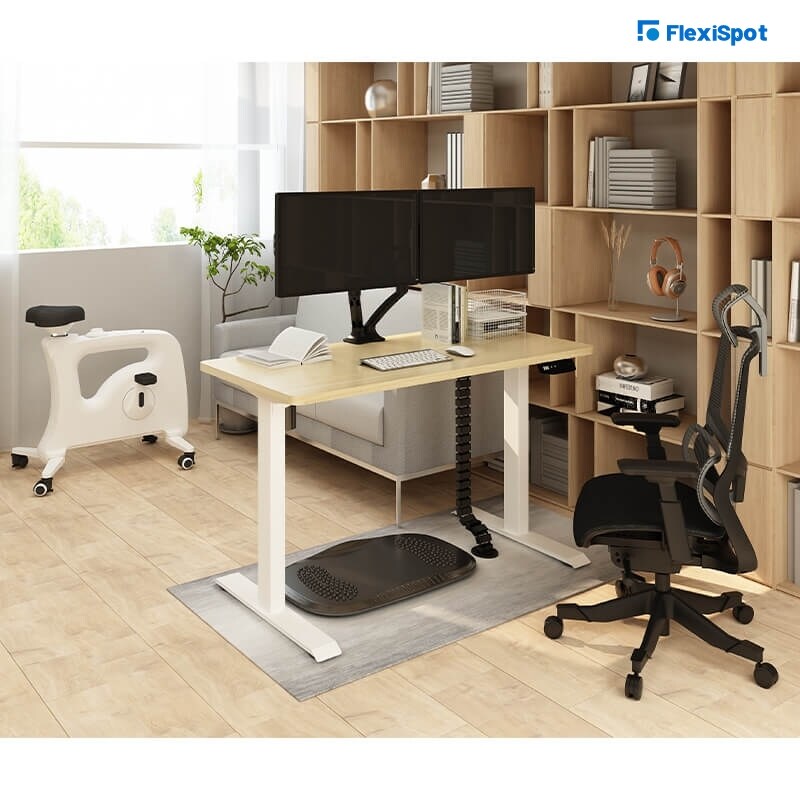A variety of factors may cause chronic shoulder discomfort.
Shoulder discomfort often occurs in stages instead of all at once. It may be difficult to determine the particular source of your discomfort. Work-related shoulder discomfort may be caused by a variety of factors, including:
uncomfortable postures
working with the arms raised above shoulder levels
even little amounts of tension or pressure on the shoulder
strain from mechanical contacts, such as that induced by typing while resting both wrists on the hard edge of the desk
Static loading occurs when the muscles are required to keep the body in one posture for an extended period of time.
vibrations in the hands and arms, such as those induced by power tools
whole-body vibrations, such as those induced by driving on bumpy roads
exposure to harsh temperatures
Shoulder discomfort and injuries aren't limited to vocations requiring much physical exertion. Workers at the office are also at significant risk of contracting them. A substantial proportion of RSIs is linked to computers. Work settings and routines that are too sedentary might weaken the muscles and lead to discomfort.
Why Are My Shoulders Hurting as A Result Of Sitting?
One word comes to mind while answering this question: posture.
One of the most common reasons for shoulder discomfort is poor sitting posture.
So, what's causing this discomfort while you're sitting? Postural discomfort is caused by a variety of factors, including:
Utilizing computers
Using cell phones
Slouching
Sedentary ways of living
According to studies, most people's muscles begin to tire after only 15 minutes of standing erect.
Is Shoulder Pain Caused by Sitting at a Desk?
Doctors may concentrate on back and neck pain caused by bad posture, but shoulder discomfort may also be caused by sitting at a computer.
As shoulder discomfort might be misinterpreted as back or neck pain, it is often neglected. Sitting at a desk may cause a shift in the shoulder's equilibrium, resulting in shoulder discomfort.
Does Sitting at A Desk Cause Shoulder Pain?
Americans are spending more time at their desks than at any other point in history, and we are definitely paying for it when it comes to our bodies.
Back and shoulder muscles are frequently weaker than frontal body muscles because of different changes in our everyday lives. Some factors include:
Long periods of sitting
Working on computers for lengthy periods of time
Use of the phone on a regular basis
Sedentary ways of living
All of these things prevent the rotator cuff inside the shoulder from operating correctly, causing tension and pain.
In addition, persistent shoulder discomfort may be caused by repetitive strain injury (RSI), also referred to as cumulative trauma disorder. Frequent, protracted, and repetitive motions may create strain on the muscles and tendons of the upper body, resulting in this syndrome.
RSI may be caused by a variety of motions, including:
Using a computer to type
Using a mouse on a computer
Uncomfortable posture or seating position
Sitting at a desk might cause shoulder discomfort that is concealed by back or neck pain. That's why it's critical to have a thorough examination to determine where the discomfort originates from.
How Can I Relieve Shoulder Tension at Work?
Stretches, easy exercises, and relaxation methods might help relieve shoulder stress while at your workstation. Take periodic pauses during the day to stop what you're doing at the desk and practice some easy shoulder shrugs.
Relax the arms and sit back in the seat with the feet resting flat on the ground. Take in a deep breath and hold it for a few seconds while shrugging the shoulders toward the ears. Let out a slow exhale and drop your shoulders. Before returning to the desk job, you may repeat this practice multiple times.
5 Ways to Stop Shoulder Pain
If you are wondering how to prevent shoulder injuries, there are a variety of common techniques you may do to alleviate back and shoulder discomfort caused by lengthy periods of sitting at a computer.
Try and incorporate the following measures into your daily life:
Exercise on a regular basis
Stretching
Yoga
Strengthening exercises for your core
Use a posture trainer to improve your posture.
Eat a balanced diet.
Reminders to adjust your posture on a regular basis
Along with these broad suggestions, the following five suggestions might help you relax the shoulder at your workstation even more.
1. Reorganize The Workspace
Correct ergonomics may help you reduce the amount of stress you put on your body when sitting at a desk.
The desk's height, the chair's height, and the computer display's height are all key aspects of good desk ergonomics.
When setting up your workstation, keep the following in mind:
Adjust the chair so that the knees and hips are at the same level.
Sit with the pelvis in a neutral posture as much as possible.
Keep hands at the level of your elbows and your wrists straight.
Set your computer display at a distance of roughly an arm's length.
Adjust the display to the same height as your eyes.
Use a footrest if necessary.
Keep the mouse in a location where the elbows stay at a 90-degree angle to avoid reaching for it.
Place your arms on the desk for support.
Keep the products and tools that you use on a daily basis handy and within easy reach.
Instead of cradling your phone between the ear and shoulder, put it on speaker or wear headphones if you're using the phone regularly.
2. Shift Your Position Frequently
The best posture is the one after that.
Since your posture deteriorates the longer you sit at the desks, it's critical to change our seating postures often during the day.
Sitting in the seat and leaning slightly before returning to a correct seated position is a simple way to do this.
Alternatively, get up and walk around.
Instead of writing a fast email, deliver the message orally to your teammate. You can also go to the cafeteria to refill the water bottle, then return to the desk and adjust the posture to a comfy and appropriate position.
3. Work On Your Posture
Keep your back straight. Make sure you're not slouching. Keep your feet firmly planted on the ground. We've all been reminded of this by our well-intentioned mothers or instructors, and they are right!
You don't like to accept it, but they are correct. You can get long-term advantages and reduced shoulder discomfort by training yourself to maintain excellent posture.
So, how does proper posture at your workstation look?
Using a footrest or putting your feet on the ground
Keep your knees and hips at the same level.
Your forearms should be parallel to the ground, and your shoulders should be relaxed.
Uncrossed legs
Use a chair or add back support to support the back. Investing in an ergonomic chair for adequate spinal support can also do wonders!
Keep your elbows close to the body.
Thighs and hips that are supported
4. Think About Getting a Standing Desk
Standing desks have never been more popular, and for a valid reason. Many regions of your body, especially your shoulders, might be relieved by standing while working.
Not only that, but doing work at a standing desk offers a slew of additional health advantages, including:
Maintaining a healthy weight
Excess weight loss; and
After meals, levels of blood sugar return to normal quicker.
Consider the following factors if you decide to switch to a standing desk:
Work for 30-60 minutes each time to ease yourself into it. Allowing the body to slowly adjust to the new posture is a good idea.
Purchase an adjustable desk that can be moved to a sitting posture for simpler and more convenient jobs to do when seated (the FlexiSpot adjustable standing desk is a great option!)
Even if you're working at a standing desk, pay attention to overall posture. Working with a standing desk while having poor posture might result in you exchanging one issue for another.
5. Take Frequent Breaks
It's easy to get engrossed in your job and pause for some intervals, yet we all need them.
Taking a vacation from time to time refreshes our brain ability and our physical body.
Get exercising every half an hour to an hour by:
Stretching
Going for a walk around the workplace
Go to the bathroom
Fill up your coffee cup again
Set up a timer or keep reminders with post-it notes near the computer to ensure you get those movement breaks in.
In Conclusion
If you want to prevent shoulder injuries, you have to incorporate some ergonomic changes to the way you work. Getting a standing desk and switching up your sitting position are just some ways that can help you avoid shoulder injuries.









